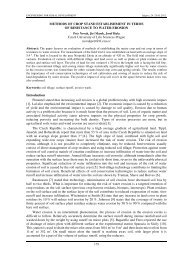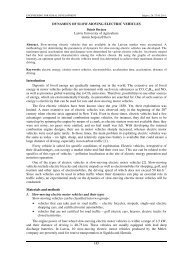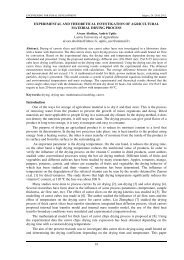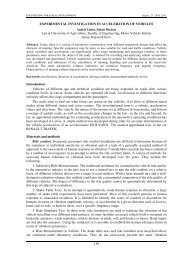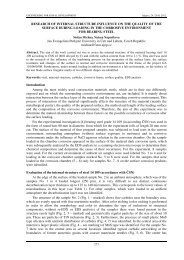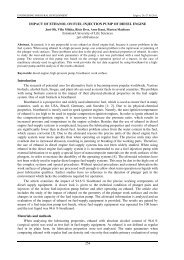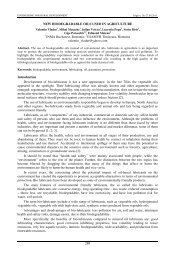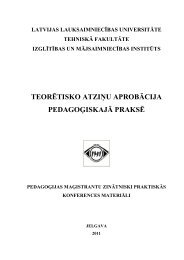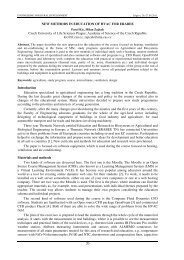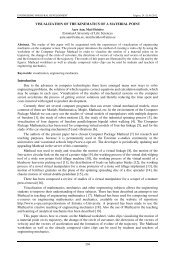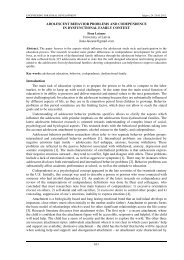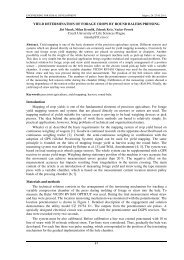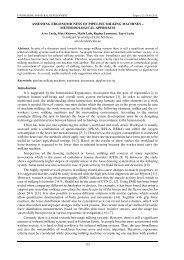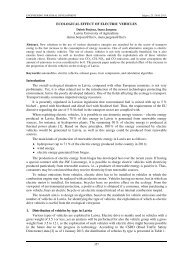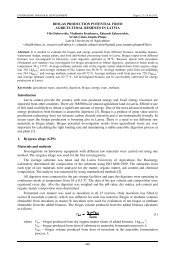Petr Valasek, Petr Chocholous Czech University of Life Sciences in ...
Petr Valasek, Petr Chocholous Czech University of Life Sciences in ...
Petr Valasek, Petr Chocholous Czech University of Life Sciences in ...
Create successful ePaper yourself
Turn your PDF publications into a flip-book with our unique Google optimized e-Paper software.
ENGINEERING FOR RURAL DEVELOPMENT Jelgava, 23.-24.05.2013.<br />
MECHANICAL PROPERTIES OF EPOXY RESINS<br />
WITH ORGANIC FILLER – WOOD FLOUR<br />
<strong>Petr</strong> <strong>Valasek</strong>, <strong>Petr</strong> <strong>Chocholous</strong><br />
<strong>Czech</strong> <strong>University</strong> <strong>of</strong> <strong>Life</strong> <strong>Sciences</strong> <strong>in</strong> Prague<br />
valasekp@tf.czu.cz<br />
Abstract. Composite materials can be characterized as a material composed <strong>of</strong> two or more phases and that<br />
phases <strong>in</strong>fluence each other synergistically. Those materials have become <strong>in</strong>dispensable <strong>in</strong> many <strong>in</strong>dustrial areas,<br />
from the aviation to the agriculture where composite materials replace the conventionally used materials such as<br />
steel. However, the composite systems f<strong>in</strong>d their application <strong>in</strong> the field <strong>of</strong> jo<strong>in</strong><strong>in</strong>g dissimilar materials, <strong>in</strong> the<br />
renovation <strong>of</strong> mach<strong>in</strong>e parts etc. This paper describes themechanical properties <strong>of</strong> composite systems consist<strong>in</strong>g<br />
<strong>of</strong> two phases – epoxy res<strong>in</strong> and wood flour. One <strong>of</strong> the benefits <strong>of</strong> polymer matrix based on epoxy res<strong>in</strong>s is its<br />
excellent resistance to the various degradation environments which are <strong>in</strong> the contact with composite materials <strong>in</strong><br />
crop and livestock production. Different mechanical and physical properties <strong>of</strong> <strong>in</strong>dividual phases def<strong>in</strong>e the<br />
properties <strong>of</strong> the result<strong>in</strong>g composite. Add<strong>in</strong>g wood flour <strong>in</strong>to the polymer materials can affect the mentioned<br />
properties and the result<strong>in</strong>g price. It is also a good way for the material recycl<strong>in</strong>g that complements conventional<br />
ways <strong>of</strong> recycl<strong>in</strong>g wood waste. It is <strong>in</strong>expensive and sensitive to the environment. The experiment describes the<br />
mechanical properties <strong>of</strong> polymer composite materials with epoxy matrix such as: hardness, impact strength,<br />
tensile strength and resistance to abrasive wear. The result<strong>in</strong>g composite systems may f<strong>in</strong>d their application <strong>in</strong><br />
the field <strong>of</strong> agriculture – especially dur<strong>in</strong>g jo<strong>in</strong><strong>in</strong>g and seal<strong>in</strong>g materials <strong>of</strong> larger units where high quality<br />
connections are not required. The experimental results confirm the hypothesis that the <strong>in</strong>teraction between the<br />
epoxy matrix and <strong>in</strong>organic filler (wood flour) creates a qualitatively new composite system for usage <strong>in</strong><br />
agriculture.<br />
Keywords: abrasive wear, hardness, impact strength, wood.<br />
Introduction<br />
The aim <strong>of</strong> the experiment was evaluation the effect <strong>of</strong> <strong>in</strong>clusion <strong>of</strong> wood flour on the mechanical<br />
properties <strong>of</strong> epoxy res<strong>in</strong>s – hardness, impact strength, tensile strength, shear strength <strong>of</strong> lap solid<br />
adherend and resistance to abrasive wear. Add<strong>in</strong>g wood flour <strong>in</strong>to res<strong>in</strong> creates composite systems.<br />
Composite systems consist <strong>of</strong> one or more phases with different mechanical, physical and<br />
chemical properties, that are <strong>in</strong> mutual <strong>in</strong>teraction, <strong>in</strong>fluence the result<strong>in</strong>g characteristics and behavior.<br />
The <strong>in</strong>dividual phases are usually referred as the filler and the matrix. Ehrenste<strong>in</strong> [1] def<strong>in</strong>es the term<br />
matrix as a material which <strong>in</strong> case <strong>of</strong> particle systems transforms <strong>in</strong> the particular component, so that<br />
after the process<strong>in</strong>g is done, a product with a fixed form is created. The filler can improve the value <strong>of</strong><br />
mechanical properties like resistance to abrasive wear, hardness, impact resistance etc.<br />
The fillerpresence <strong>in</strong> the matrix then <strong>in</strong>fluences also a number <strong>of</strong> other features, such as the<br />
characteristics <strong>of</strong> strength, density and cost [2-6].<br />
All parameters <strong>in</strong>fluenc<strong>in</strong>g the characteristics <strong>of</strong> composite materials are related either to their<br />
structure, or to the relations between phases. The <strong>in</strong>dividual phases <strong>in</strong>fluence the result<strong>in</strong>g<br />
characteristics <strong>of</strong> the material by their own characteristics and by the mutual <strong>in</strong>teraction <strong>of</strong> the matrix<br />
and the filler. And it is the <strong>in</strong>teraction between the fractions that enables us to contribute to materials<br />
with new qualities [3; 7].<br />
Wood flour is generated by wood process<strong>in</strong>g or its own m<strong>in</strong><strong>in</strong>g, where bark, branches, sawdust<br />
and wood chips are collected and subsequently processed <strong>in</strong>to wood flour. A common way for the<br />
recycl<strong>in</strong>g wood is chipboard manufacture or burn<strong>in</strong>g. Another, less conventional method <strong>of</strong> recycl<strong>in</strong>g<br />
wood - material use, is <strong>in</strong>teraction wood flour with different types <strong>of</strong> polymer materials, such as<br />
polyolef<strong>in</strong>s (high density polyethylene).<br />
Kumar et al. [8] <strong>in</strong> their research summarize the positive properties <strong>of</strong> polymers filled with wood<br />
flour. They stated the low density, availability and biodegradability <strong>of</strong> organic fillers. The application<br />
area <strong>of</strong> polymers filled with wood flour can be broad: e.g., construction and automotive <strong>in</strong>dustries.<br />
Wood flour is one <strong>of</strong> the most accessible organic fillers. Suitable materials for add<strong>in</strong>g wood flour are<br />
ma<strong>in</strong>ly high-density and low-density polyethylene, l<strong>in</strong>ear low-density polyethylene, and<br />
polypropylene. The <strong>in</strong>teraction <strong>of</strong> the filler and polymer under optimum conditions and composition<br />
lead to improve the mechanical, chemical and thermal properties <strong>of</strong> re<strong>in</strong>forced polymer [9]. Al<br />
232
ENGINEERING FOR RURAL DEVELOPMENT Jelgava, 23.-24.05.2013.<br />
Maadeed et al. [10] <strong>in</strong> their research fulfill recycled polypropylene (RPP) by wood flour and glass<br />
fibers. The presence <strong>of</strong> wood flour <strong>in</strong>creased the tensile strength and elasticity modulus <strong>of</strong> the<br />
composite. These properties were improved by add<strong>in</strong>g another phase – glass fibers. Ou et al. [11]<br />
replaced the glass fibers by kevlar fibers, which had a similar positive effect on high-density<br />
polyethylene composites filled with wood flour.<br />
Improvement <strong>of</strong> the modulus <strong>of</strong> elasticity and flexural strength <strong>in</strong>crease (polypropylene) are also<br />
recorded by Ndiaye et al. [12] Similar results - an <strong>in</strong>creased modulus <strong>of</strong> elasticity for PP filled with<br />
wood flour observed Perez et al. [13]. Mosiewicki et al. [14] <strong>in</strong> his work mentions reduc<strong>in</strong>g creep<br />
deformation <strong>of</strong> Oil-Based Polyester thermosets filled by wood flour.<br />
Materials and methods<br />
For carried out experiments the two-component epoxy res<strong>in</strong> ECO-EPOXY 1200/324 with the<br />
cur<strong>in</strong>g agent P11 was chosen. The cur<strong>in</strong>g time <strong>of</strong> this res<strong>in</strong> is 24 hours at 23 ºC. The total cur<strong>in</strong>g<br />
occurs after 7 days. Epoxy res<strong>in</strong>s are widely used <strong>in</strong> agriculture [15; 16]. As filler, wood flour was<br />
used. Specifically, there were spruce wood particles smaller than 100 µm. Composite systems were<br />
prepared with filler volume percentage <strong>of</strong> 5, 10, 15 and 20 %. The formulation <strong>of</strong> the filler part by<br />
volume elim<strong>in</strong>ates the <strong>in</strong>fluence <strong>of</strong> the different density between the matrix (1.15 g·cm -3 ) and the filler<br />
(0.50 g·cm -3 ). The tested samples were casted <strong>in</strong>to forms from two-component silicone rubber. A rise<br />
<strong>of</strong> air bubbles dur<strong>in</strong>g the mechanical preparation <strong>of</strong> the mixture (mix<strong>in</strong>g) was elim<strong>in</strong>ated <strong>in</strong> an<br />
ultrasonic vat. Harden<strong>in</strong>g was carried out accord<strong>in</strong>g to the technological requirements <strong>of</strong> the res<strong>in</strong><br />
producer.<br />
As guide for the hardness determ<strong>in</strong>ation <strong>of</strong> the composite systems the standard CSN EN ISO<br />
2039-1 was used. The tested specimen dimensions were <strong>of</strong> 35 x 25 x 9 mm. The ball from hard metal<br />
<strong>of</strong> 10 mm diameter was used. The tested specimens were loaded us<strong>in</strong>g the force <strong>of</strong> 2.452 kN for the<br />
duration <strong>of</strong> 30 s.<br />
The two body abrasion was tested on a rotat<strong>in</strong>g cyl<strong>in</strong>drical drum device with the abrasive cloth <strong>of</strong><br />
the gra<strong>in</strong> size P220 (Al 2 O 3 gra<strong>in</strong>s) accord<strong>in</strong>g to the standard CSN 62 1466. The test<strong>in</strong>g mach<strong>in</strong>e with<br />
the abrasive cloth consists <strong>of</strong> the rotat<strong>in</strong>g drum on which the abrasive cloth is affixed by means <strong>of</strong> a<br />
bilateral adhesive tape. The test<strong>in</strong>g specimen is secured <strong>in</strong> the pull<strong>in</strong>g head and dur<strong>in</strong>g the test it is<br />
shifted by means <strong>of</strong> a mow<strong>in</strong>g screw along the abrasive cloth from the left edge <strong>of</strong> the drum to the<br />
right one. The test<strong>in</strong>g specimen is <strong>in</strong> contact with the abrasive cloth and it covers the distance <strong>of</strong> 60 m.<br />
Dur<strong>in</strong>g one drum turn <strong>of</strong> 360º it is provoked that the test<strong>in</strong>g specimen is left above the abrasive cloth<br />
surface. Consequent impact <strong>of</strong> the test<strong>in</strong>g specimen simulates the concussion. The pressure force is<br />
10 N. The mean <strong>of</strong> the test<strong>in</strong>g specimens was 15.5 ± 0.1 mm and their height was 20.0 ± 0.1 mm. The<br />
mass decreases were measured on analytic scales weigh<strong>in</strong>g on 0.1 mg. The volume decreases were<br />
calculated on the basis <strong>of</strong> the found out volume and the density <strong>of</strong> the composite systems.<br />
For the lap-shear strength description <strong>in</strong> the boundary adherend – composite system the lap<br />
assemblies were made. The surface <strong>of</strong> 1.5 mm thick steel sheets, onto which the composite system was<br />
applied, was at first blasted us<strong>in</strong>g the synthetic corundum fraction F80 under the angle <strong>of</strong> 90º. In this<br />
way the average surface roughness <strong>of</strong> Ra = 1.79 ± 0.24 µm was reached. Then the surface was cleaned<br />
and degreased us<strong>in</strong>g perchlorethylene and prepared to the composite mixture application.<br />
Accord<strong>in</strong>g to the standard CSN EN ISO 527 (Determ<strong>in</strong>ation <strong>of</strong> tensile properties) the destructive<br />
tests were carried out.<br />
The impact strength was evaluated based on the norm CSN 64 0611. In these destructive tests, the<br />
Dynstat device nr. 283 stated the impact strength, which expresses the k<strong>in</strong>etic energy <strong>of</strong> the hammer<br />
needed to crush the tested object without notches <strong>in</strong> relation to the surface <strong>of</strong> its diagonal cut.<br />
The representation <strong>of</strong> the fracture surface and adhesive layers was carried out us<strong>in</strong>g a stereoscopic<br />
microscope (ow<strong>in</strong>g to the chips shape irregularity expressed <strong>in</strong> 2D flat surface).<br />
A statistical evaluation <strong>of</strong> the results was carried out by means <strong>of</strong> a program Statistica – one factor<br />
ANOVA, reliability level α = 0.05. For statistical comparison the Tukey’s HSD test was used.<br />
Statistical match<strong>in</strong>g <strong>of</strong> the data sets is <strong>in</strong>dicated <strong>in</strong> the column.<br />
233
ENGINEERING FOR RURAL DEVELOPMENT Jelgava, 23.-24.05.2013.<br />
Results and discussion<br />
Wood flour reduced the density <strong>of</strong> the composite system and its <strong>in</strong>clusion did not change Br<strong>in</strong>ell<br />
hardness significantly accord<strong>in</strong>g to the values obta<strong>in</strong>ed from the res<strong>in</strong> without fillers, see Tab 1. Table<br />
1 stated the theoretical density <strong>of</strong> the composite system. Actual density <strong>of</strong> the composite system can be<br />
different accord<strong>in</strong>g to this value due to the occurrence <strong>of</strong> air bubbles <strong>in</strong> the material structure.<br />
Table 1<br />
Density, hardness <strong>of</strong> composite systems<br />
Filler, % ρ teo , g·cm -3 HBW10/250/30<br />
0 1.15 11.21 ± 0.53<br />
5 1.12 11.53 ± 0.20<br />
10 1.08 11.89 ± 0.41<br />
15 1.05 12.36 ± 0.44<br />
20 1.01 11.75 ± 0.16<br />
Abrasive wear resistance <strong>of</strong> the composite systems showed a slight <strong>in</strong>crease <strong>of</strong> the volume and<br />
weight losses compared to res<strong>in</strong> without fillers, see Fig. 1.<br />
Volume loss, cm 3<br />
Weight loss, g<br />
Filler, %<br />
Fig. 1. Volume and weight losses<br />
The values <strong>of</strong> the impact strength <strong>of</strong> the composites decreased significantly <strong>in</strong> comparison with<br />
the unfilled res<strong>in</strong> (5.22 ± 0.91 kJ·m -2 ), see Fig. 1 – statistically comparable with the values <strong>of</strong> the res<strong>in</strong><br />
were only composite systems with 5% <strong>of</strong> filler <strong>in</strong> the matrix (4.11 ± 1.08 kJ·m -2 ), see Fig. 1. The<br />
measurements were affected by significant errors, which are shown graphically by standard deviations<br />
(Fig. 2). The coefficient <strong>of</strong> variation reached up to 30 %.<br />
F(4, 45) = 13.242, p = 0.00000<br />
% Mean, kJ·m -2 Agreement<br />
20 2.547347 *<br />
15 2.965573 * *<br />
10 3.357244 * *<br />
5 4.117490 * *<br />
0 5.217385 *<br />
Impact strength, MPa<br />
Fig. 2. Impact strength, Tukey’s HSD test (left)<br />
On Fig. 3 the comparison <strong>of</strong> the shear strength <strong>of</strong> rigid adherend is shown. The shear strength <strong>of</strong><br />
the composite systems was statistically identical <strong>in</strong> the range 5-20 %. The shear strength <strong>of</strong> epoxy<br />
res<strong>in</strong> without fillers was always higher (11.48 ± 0.42 MPa).<br />
234<br />
Filler, %
ENGINEERING FOR RURAL DEVELOPMENT Jelgava, 23.-24.05.2013.<br />
F(4, 25) = 8.1815, p = 0.00023<br />
% Mean, MPa Agreement<br />
20 8.42236 *<br />
15 9.33297 *<br />
10 9.50055 *<br />
5 9.80589 *<br />
0 11.48167 *<br />
Shear strength, MPa<br />
Filler, %<br />
Fig. 3. Lap-shear tensile strength, Tukey’s HSD test (left)<br />
The fracture surfaces <strong>of</strong> lap jo<strong>in</strong>ts were evaluated and these surfaces showed signs <strong>of</strong> adhesion<br />
failure. Due to <strong>in</strong>creas<strong>in</strong>g the proportion <strong>of</strong> fillers <strong>in</strong> the matrix bigger gaps between adherend<br />
occurred. The mean value <strong>of</strong> the gap width for the composite systems with 5 % filler matches<br />
0.20 mm, for 20 % 0.7 mm (values measured on stereoscopic microscope, see Fig. 4).<br />
Fig. 4. Gap width (20%)<br />
The tensile strength <strong>of</strong> the specimen representative cohesive characteristics <strong>of</strong> the composite<br />
systems and epoxy res<strong>in</strong> is shown <strong>in</strong> Fig. 5.<br />
F(4, 25) = 8.1815, p = 0.00023<br />
% Mean, MPa Agreement<br />
20 18.26667 *<br />
15 20.53433 *<br />
10 20.77000 *<br />
5 21.64833 *<br />
0 42.93333 *<br />
Strength, MPa<br />
Filler, %<br />
Fig. 5. Tensile strenght, Tukey’s HSD test<br />
From the Tukey’s test it is clear that <strong>in</strong> the range 5-20 % there are no changes <strong>in</strong> the values <strong>of</strong><br />
tensile strength, but also it is clear that all composite systems have significantly lower values <strong>of</strong> tensile<br />
235
ENGINEERING FOR RURAL DEVELOPMENT Jelgava, 23.-24.05.2013.<br />
strength than unfilled res<strong>in</strong> (42.93 ± 1.68 MPa). A typical tensile diagram for the composite system<br />
(5 %) and res<strong>in</strong> without filler is shown <strong>in</strong> Fig. 6.<br />
Epoxy res<strong>in</strong><br />
Composite<br />
Stress, MPa<br />
Stra<strong>in</strong>, mm<br />
Fig. 6. Tensile strength diagram<br />
Conclusion<br />
The experiment did not verify the hypothesis <strong>of</strong> the authors [8-13], who fill the thermoplastic<br />
materials by wood flour. Inclusion <strong>of</strong> wood flour decreased the impact resistance <strong>of</strong> the composites<br />
compared to the res<strong>in</strong> without fillers up to 51 %, tensile strength <strong>of</strong> lap adherend by 27 %, tensile<br />
strength represent<strong>in</strong>g cohesive characteristics up to 57 %. In the area <strong>of</strong> hardness and abrasive wear <strong>in</strong><br />
the <strong>in</strong>terval 5-20 % filler <strong>in</strong> the matrix significant changes have not occurred compared to res<strong>in</strong><br />
without filler. The benefits can <strong>in</strong>clude reduced cost <strong>of</strong> composites, i.e., at 20 % <strong>of</strong> filler 1 EUR·kg -1 .<br />
The assumed price per kilogram epoxy res<strong>in</strong> is 10 EUR.<br />
Based on the experiment these composite systems can be used <strong>in</strong> agrocomplex for seal<strong>in</strong>g and<br />
bond<strong>in</strong>g larger units that do not require high quality connections, i.e., where the reached mechanical<br />
properties <strong>of</strong> the composite systems are sufficient.<br />
Acknowledgement<br />
This paper has been done when solv<strong>in</strong>g the grant IGA TF.<br />
References<br />
1. Ehrenste<strong>in</strong> G. W. Polymer composite materials. First edition. Prague: Scientia, 2009. 351 p.<br />
2. Kim B.C., Park S.W., Lee D.G. Fracture toughness <strong>of</strong> the nano-particle re<strong>in</strong>forced epoxy<br />
composite. Composite Structures, Vol. 86, 2008 Elsevier, pp. 69-77.<br />
3. Agarwal D., Broutman J. Fiber Composites. Prague: SNTL, 1987. 294 p.<br />
4. Müller M., Valášek P. Abrasive wear effect on Polyethylene, Polyamide 6 and polymeric particle<br />
composites, Manufactur<strong>in</strong>g Technology, Vol. 12, 2012, pp. 55-59.<br />
5. Valášek P., Müller M. Polymeric particle composites with filler saturated matrix. Manufactur<strong>in</strong>g<br />
Technology, Vol. 12, Nr. 13, 2012, pp. 272-276.<br />
6. Valášek P., Müller M. Impact strength <strong>of</strong> polymer particle composites with filler on the basis <strong>of</strong><br />
corundum waste. In 11 th International scientific conference eng<strong>in</strong>eer<strong>in</strong>g for rural development.<br />
Jelgava: LUA, 2012, pp. 304-308.<br />
7. Müller M. Polymeric composites based on Al 2 O 3 re<strong>in</strong>forc<strong>in</strong>g particles. In 10 th International<br />
scientific conference eng<strong>in</strong>eer<strong>in</strong>g for rural development. Jelgava: LUA, 2011, pp. 423-427.<br />
8. Kumar V., Tyagi L., S<strong>in</strong>ha S. Wood flour-re<strong>in</strong>forced plastic composites: a review. Reviews <strong>in</strong><br />
chemical eng<strong>in</strong>eer<strong>in</strong>g, Vol. 27, No. 5-6, 2011, pp. 253-264.<br />
9. Ghahri S., Najafi S.K. et al. Impact strength improvement <strong>of</strong> wood flour-recycled polypropylene<br />
composites. Journal <strong>of</strong> applied polymer science. Vol. 124, No. 2, 2012, pp. 1074-1080.<br />
10. Al Maadeed M. A., Kahraman R., et al. Date palm wood flour/glass fibre re<strong>in</strong>forced hybrid<br />
composites <strong>of</strong> recycled polypropylene: Mechanical and thermal properties. Materials & Design,<br />
Vol. 42, 2012, pp. 289-294.<br />
11. Ou R., Zhao H., et al.: Re<strong>in</strong>forc<strong>in</strong>g effects <strong>of</strong> Kevlar fiber on the mechanical properties <strong>of</strong> woodflour/high-density-polyethylene<br />
composites. Composites part A-applied science and<br />
manufactur<strong>in</strong>g, Vol. 41, No. 9, 2010, pp. 1272-1278.<br />
236
ENGINEERING FOR RURAL DEVELOPMENT Jelgava, 23.-24.05.2013.<br />
12. Ndiaye D., Matuana LM. et al. Journal <strong>of</strong> applied polymer science. Vol. 119, No. 6, 2011, pp.<br />
3321-3328.<br />
13. Perez E., Fama L., et al. Tensile and fracture behaviour <strong>of</strong> PP/wood flour composites. Composites<br />
part B-eng<strong>in</strong>eer<strong>in</strong>g. Vol. 43, No. 7, Special Issue, 2012, pp. 2795-2800.<br />
14. Mosiewicki M.A., Marcovich N.E., Aranguren M.I. Creep Behavior <strong>of</strong> Wood Flour Composites<br />
Made from L<strong>in</strong>seed Oil-Based Polyester Thermosets. Journal <strong>of</strong> applied polymer science Vol.<br />
121, No. 5, 2011, pp. 2626-2633.<br />
15. Müller M. Influence <strong>of</strong> surface <strong>in</strong>tegrity on bond<strong>in</strong>g process. Research <strong>in</strong> Agricultural<br />
Eng<strong>in</strong>eer<strong>in</strong>g, Vol. 57, No. 4, 2011, pp. 153-162.<br />
16. Müller M., Herák D. Dimension<strong>in</strong>g <strong>of</strong> the bonded lap jo<strong>in</strong>t. Research <strong>in</strong> Agricultural Eng<strong>in</strong>eer<strong>in</strong>g,<br />
Vol. 56, No. 2, 2010, pp. 59-68.<br />
237



